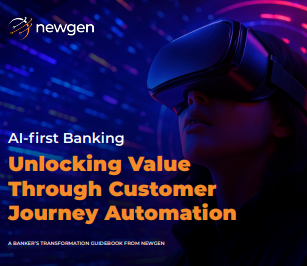Banking Is Changing Fast
The way customers interact with banks has transformed dramatically. People now expect the same speed, convenience, and personalization from their bank as they do from everyday digital experiences like shopping on Amazon or booking a ride on Uber.
They want quick account openings, instant loan approvals, and smooth, paperless interactions. But behind the scenes, many banks are still weighed down by slow, manual processes employees juggling multiple systems, data entered over and over, customers downloading and emailing forms. What could be done in minutes often stretches into days.
It’s frustrating for customers, expensive for banks, and limiting for growth.
That’s where customer journey automation comes in. By combining AI, process automation, and connected digital platforms, banks can redesign how work gets done and deliver truly modern, seamless experiences while cutting costs and staying compliant.
Why Rethinking Customer Journeys Matters?
Over the last few years, banks have invested heavily in technology. But spending alone doesn’t solve the problem. Many institutions simply add new tools on top of legacy systems and end up with more complexity, not less.
When banks step back and redesign their customer journeys end to end, the impact is huge:
- 20% more completed applications for loans and deposits
- 40% lower customer acquisition costs
- 50% less operational effort and expense
The lesson is clear transformation isn’t about small tweaks; it’s about rethinking how customers engage with the bank at every step.
Breaking the Biggest Bottlenecks
1. Frictionless Onboarding
Opening an account should be simple but too often, it’s anything but. Manual KYC checks, separate systems for compliance and account setup, and requests for physical signatures all slow things down.
By automating onboarding:
- Customer details are captured once and reused across systems.
- Identity and compliance checks run automatically in the background.
- Digital forms and e-signatures replace paper and scanning.
Banks using digital onboarding have seen up to 60% fewer drop-offs and 40% faster acquisition. For customers, it feels effortless. For banks, it means happier clients and more accounts opened.
2. Loan Origination Without the Paper Chase
Lending is the lifeblood of banking, but traditional loan processes are clunky. Information gets typed multiple times, documents move from desk to desk, and decisions take longer than they should.
An automated, AI-powered loan journey looks very different:
- Data flows seamlessly from application to underwriting to funding.
- Simple approvals happen instantly with rules-based decisioning.
- Documents are classified, prepared, and signed digitally.
- Compliance steps (like OFAC screening) are built right into the workflow.
Some banks have cut loan processing from two days to just 30 minutes while freeing employees to focus on complex cases and customer relationships.
3. Supporting Small Business Growth
Small business lending can be tricky because it blends consumer and commercial requirements. But AI is helping banks open new doors safely and efficiently.
By analyzing alternative data like transaction patterns, payment histories, and public records banks can better assess risk and responsibly approve more loans for small businesses, even those with limited credit histories. This means supporting local entrepreneurs and expanding into new market segments without taking on unnecessary risk.
Making Automation Smarter With AI
Automation speeds things up. AI makes it intelligent. Forward-looking banks are weaving AI into their digital platforms to deliver even more value:
- Document Understanding: AI extracts data from financial statements, tax returns, and identity documents automatically, reducing manual entry by up to 70%.
- Better Credit Decisions: Machine learning models combine traditional and alternative data for fairer, more accurate risk assessments.
- Fraud Prevention: AI detects unusual patterns and behaviors in real time stopping fraud before it happens without disrupting legitimate customers.
- Personalization at Scale: Predictive analytics suggest the right product or next best action, so customers get timely, relevant offers.
This isn’t just about efficiency; it’s about deeper relationships, stronger risk controls, and reaching previously underserved customers.
One Platform, Not a Patchwork of Tools
Many banks have grown their digital stack piece by piece one system for onboarding, another for lending, something else for compliance. The result? Complexity, silos, and high IT costs.
The better approach is a unified digital banking platform that connects everything. With one foundation, banks get:
- A single source of customer data no rekeying or duplication.
- Pre-built integrations to core systems and third-party services.
- Low-code flexibility to adapt fast when regulations or market needs change.
- Cloud deployment for scalability and cost savings.
This integrated model creates consistency across channels and products while making it far easier to launch new services.
How Newgen Makes It Possible?
At the center of this shift is NewgenONE Newgen’s AI-first, low-code digital transformation platform. Built for modern banking, it combines automation, content services, AI/ML, and customer engagement in one place.
With Newgen, banks can:
- Open accounts digitally with fewer drop-offs and full compliance.
- Streamline lending across consumer, commercial, and small business segments with AI-driven underwriting and faster funding.
- Enable straight-through processing to handle routine approvals automatically and free up staff for high-value work.
- Modernize transaction banking for trade and supply chain finance while staying compliant with global standards.
Proven results include:
- Up to 45% faster loan disbursement
- 60% lower onboarding abandonment
- ROI of 371% within three years (Forrester TEI study)
Why Now Is the Time?
Fintechs and challenger banks are raising the bar for speed and simplicity. Regulations are getting stricter. Costs are rising. And customer loyalty depends on seamless digital experiences.
For traditional banks and NBFCs, standing still isn’t an option. Customer journey automation isn’t just an upgrade it’s a strategic move to stay competitive, reduce risk, and grow profitably.
Start Your Transformation
If you’re looking to deliver effortless customer experiences, cut operational complexity, and embrace AI-first banking, it’s time to act.

